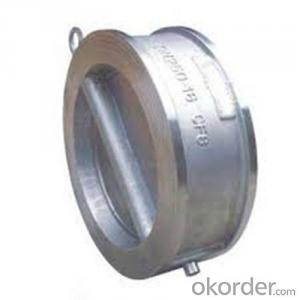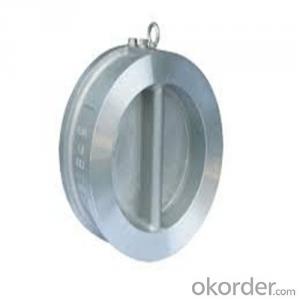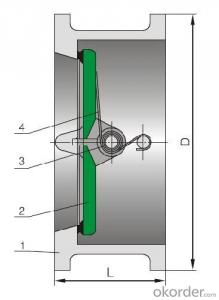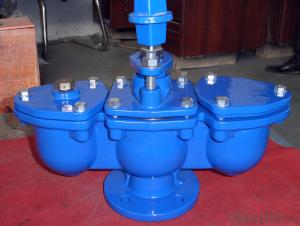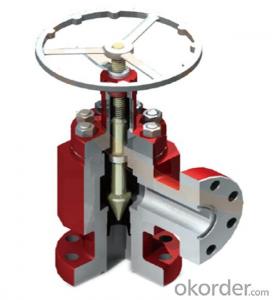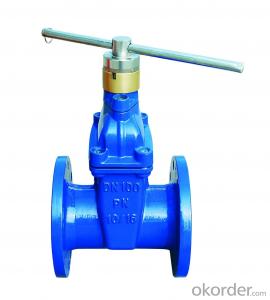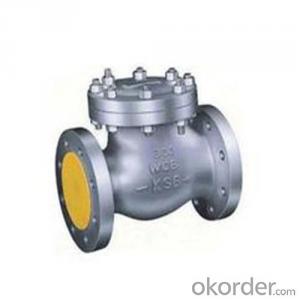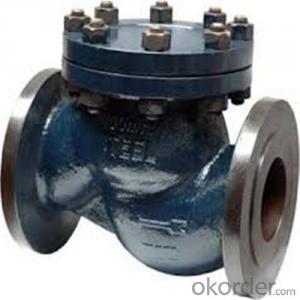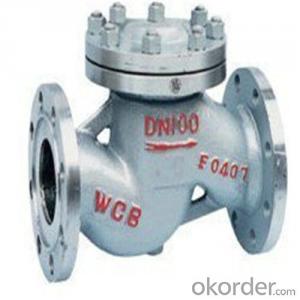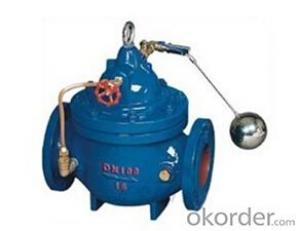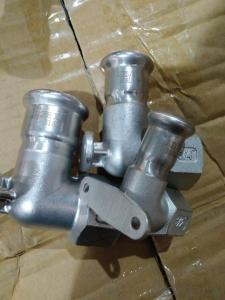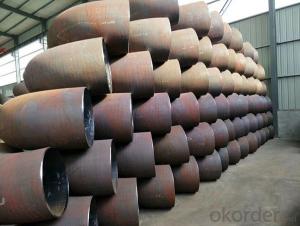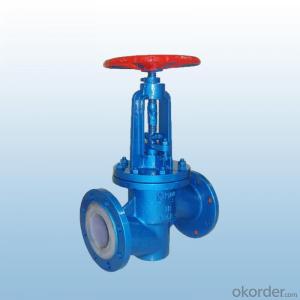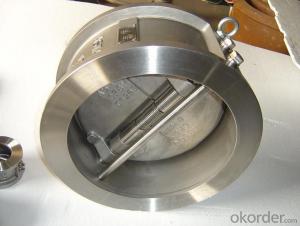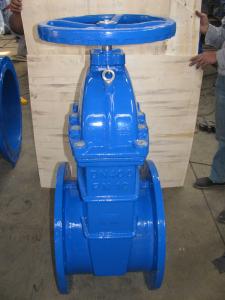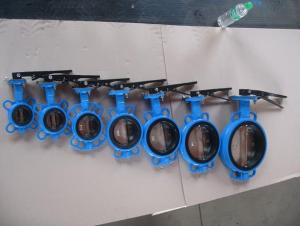Swing Check Valve Wafer Type Double PN 4 Mpa
- Loading Port:
- Shanghai
- Payment Terms:
- TT OR LC
- Min Order Qty:
- 10 pc
- Supply Capability:
- 100 pc/month
OKorder Service Pledge
OKorder Financial Service
You Might Also Like
Products Description of Swing Check Valve
Check valves are used in pipes under pressures between PN1.6~16.0MPa(Class150~2500Lb), working temperatures-196~600℃, They are used in industries include oil, chemistry, pharmaceutical, fertilizer, and power gene-ration to prevent the backward flux of the media.
The main structure features of Swing Check Valve:
1、The products feature a reasonable structure, reliable seal, good performance and nice modeling.
2、Either soft or hard seal can be selected for the product upon different working conditions.The sealing face is built up with Co-based
carbide alloy, leaving a better wearability, corrosion and scrap resistance and a longer duration.
3、Small opening pressure, the disc can be opened fully with a very small pressure differential.
4、Inside-set bolt-bearing structure reduces leakage and reliable use.
5、PN≥16.0Mpa (class1500), the middle cavity uses a self-tightening sealing structure to have the sealing performance reinforced along
with the pressure rise so as to ensure the sealing performance.
6、Different parts materials and different sizes for flange, butt-welding are available for sensible combination according to different working facts and customers' requirements.
Parameter of Swing Check Valve:
Standard Criteria | GB customize |
Pressure Rating | 1 Mpa 1.6 Mpa 2.5 Mpa 4 Mpa 6.4 Mpa 10 Mpa 16 Mpa customize |
Valve Size | 50 mm 65 mm 80 mm 100 mm 125 mm 150 mm 200 mm 250 mm 300 mm 350 mm 400 mm 450 mm 500 mm 600 mm customi |
Actuator | Automatic customize |
Connection | Wafer customize |
Medium | Oil Steam Water customize |
Medium Temperature | -196~600℃ customize |
Structural style | Swing double-clack structure customize |
Application Fields | Agriculture Electricity Medical Petrochemical customize |
1-Body Material | CF3 CF8C CF8 WCB CF8M CF3M customize |
2-Disc | CF3 CF3M WCB CF8 CF8M CF8C customize |
3-Pivot | 1Cr13 1Cr18Ni9Ti 0Cr18Ni12Mo2Ti 2Cr13 customize |
4-Spring | 60Si2Mn 1Cr18Ni9Ti 4Cr13 0Cr18Ni12Mo2Ti customize |
Design Standard | GB/T 12224 customize |
Connection Standard | GB/T 9113 HG 20592 JB/T 79 customize |
Test Standard | JB/T 9092-1999 customize |
Face to Face | GB/T 15188.2-1994 customize |
Images of Swing Check Valve:
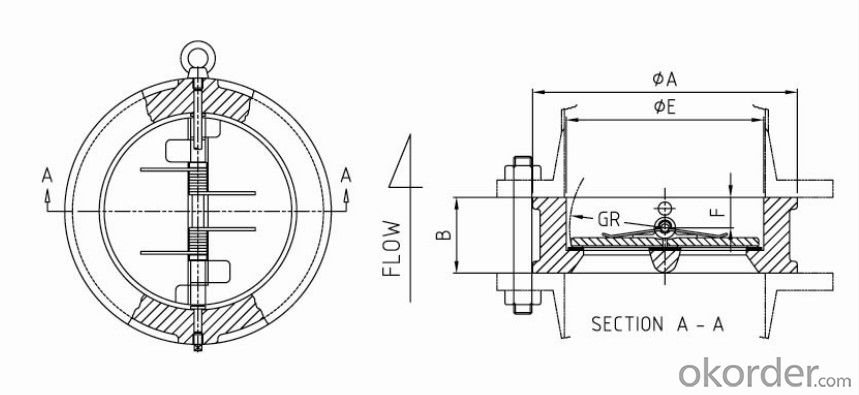
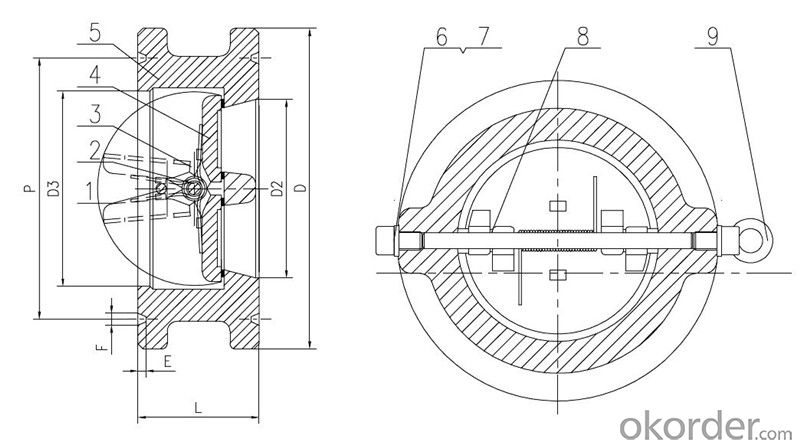

FAQ of Swing Check Valve:
Q1:I can’t find the type of steel check valve which I need. what can I do?
The chart above only lists out some common composition of steel check valve parts.We may provide other different parts material composition according to the customer's request or the actual valve working condition.
Q2:Which certification do your products pass?
Our products are in accordance with ISO 9001、ISO 14001、API 6A、API 6D、TS CE、API607/6FA/BS
Q3:How can I place an order?
The only one thing you should do is to tell us the sepecification about type 、quantity and mode of transportation, then we will send you quotation within 24 hours.
- Q:My 99 accord has been smoking bluish white smoke out of the exhaust only at high RPMS- 5000 and up, but NOT at lower RPMS. Obviously I rarely go that high, but I've feared the worst. I've checked the coolant, its green without contamination. today a mechanic discovered that someone installed the wrong pcv valve on the car- the one that belongs on the v6 model, and that it is somehow larger. the mechanic suggested it was possible that this was the cause of the smoke- the oil was getting into the intake manfold, and into the cat, and that when the engine is at higher rpms, and the gases/ heat increase, it burns up the oil in the manifold/cat. He said IF that is the cause it should clear up in a week or so. Does this sound to good to be true? or is it possible? the car does have 160,000 on it, but i've owned several hondas with much more mileage that didn't smoke at all.
- Maybe. What wt oil do you use?5w30 or 10w40? 10w40 in a 160,000 engine might also be what ya need. If ya live in an area that stays fairly hot ya might even try 20w 50 or straight 30 wt
- Q:It has been known that although tissue valves have lower rates of thrombotic episodescompared with mechanical valves, they are difficult to procure, and their longevity has not yet been proven. Is this true as of 2007? Thanks for answering.
- It is not true that tissue valves are difficult to procure--they are widely available from several manufacturers worldwide. Traditional wisdom has long held that tissue valves are for the elderly, but with the use of third generation tissue valves, which are treated to prevent calcification, in the hands of a top surgeon in a high-volume center, the choice is not so cut-and-dried anymore. Many top surgeons believe the newer tissue (porcine or bovine pericardial) valves will last twenty-five years or more (although, admittedly, they have not been studied long enough to prove this). Many top surgeons recommend the tissue valves in all but the mitral position for their patients in their 40's or even younger, believing that the risks of life-long anticoagulation therapy (which is required if one has a mechanical valve) can be greater than the risks involved in a second open heart surgery for valve replacement for some patients. What it comes down to is that valve choice is a highly individual matter--what may be the right choice for one patient of any given age may not be the right choice for another person of the same age. The following links are invaluable for making this very important decision. Do remember, whatever valve is chosen, the surgery will prolong life for the needy recipient. Whatever the choice, the patient should make it and never look back!
- Q:Grade seven, my teacher's a pain. She didn't even explain the 'sets', we just know what valves are in general. So.. which set of valves closes when the ventricles contract? Relax? Thank you so much!***10 POINTS***
- There are two types of valves in the heart: the atrio-ventricular (AV) valves and the semi-lunar valves. There are two AV valves: the tricuspid between the right atrium and the right ventricle, and the mitral (also called bicuspid) between the left atrium and the left ventricle. There are also two semi-lunar valves: the pulmonic semi-lunar, between the right ventricle and the pulmonary trunk (artery) and the aortic semi-lunar, between the left ventricle and the aorta. During diastole (the relaxation phase), the AV valves are open and the semi-lunar valves are closed, so the ventricles can fill with blood. During systole (the contraction phase), the AV valves close and the semi-lunar valves open so the blood can be pumped around the body.
- Q:I just dropped my 3rd valve slide from my trumpet on the ground. It fell with the curved end first. I can't see any dents and it doesn't look bent, but I oiled it and everything and it's really hard to move. Could it be bent? How can I fix it?
- Be sure that it is aligned correctly when you place it back in the valve casing. When you are putting it back in, it has to turn until you hear a click, indicating that the valve guide has fallen in the right space. This aligns the valve with all the ports. (The valve guide is a small plastic piece located under the valve spring. This valve guide must snap into a little notch inside the casing. When it does, the valve will be perfectly aligned. You will know when the valve guide is in the right place because you will feel and hear a click and the valve will not rotate any longer.) After thorough cleaning, oiling, and correct valve placement, if you still notice it sticking, take it to a repair shop to have it chemically cleaned. They are typically very good and will ensure your trumpet is in proper playing condition.
- Q:My 91 GMC Van has an Idle Control Valve that is unplugged, but the van still runs great. Will the valve being unplugged, result in harm to my vehicle?
- As long as the eng check light isn't on then it will harm nothing. If the light is on but the van runs good it's because the computer is running in a fixed parameters ( emergency mode ) and it's not running at top potential.
- Q:What exactly are valves and cylinders when talking about car engines? Say a car has 3 cylinders or 8 valves for example.
- There are intake valves and exhaust valves. On the intake side, the intake valve opens which lets the fuel/air mixture into the combusion chamber. At some point (measured in degrees of crank rotation) the intake valve closes, the air/fuel mixture is compressed and ignited by the spark plug. Then the spent mixture exits the cylinder when the exhaust valve opens. Valve configuration varies somewhat, but regardless of how many valves there are there will always be at least one intake and one exhaust valve. Some cylinder heads have 2 intake and 2 exhaust valves which is what is described as the 4-valve per cylinder setup. Regarding Car Cylinders, the answerer says Cylinders in a car engine are pretty much like rowers in a boat. But they are not. Rowers always row in synch with each other. Cylinders are made to be out-of-sync for smoother operation. The more cylinders you have, the smoother the engine runs. Compare a 1-cylinder minibike with a 4-cylinder motorcycle (both air-cooled), or a 4-cylinder to an eight... big difference in smoothness.
- Q:I know what a valve is, but I would like to know what an actuator does?
- Use solenoids or mod valves. Use my profile to email me. Mod valves are for variable solenoids are for open shut. Email and tell me more about what you need to sense or what application.
- Q:like they say on 4 strokes you gotta go get valve jobs, and they cost bout 300 they say? well what does the mechanic do? can it be done at home and your just adjusting them?
- i'm 18 and race a crf40r i admire the motorbike. in case you desire to flow extra decrease priced i might decide for 2 stroke. have faith it or not 2 stroke is extra maintence even though it is lots extra decrease priced to rebuild. A 2 stroke on long tracks with enormous sweapers is purely as speedy as a 450 if not speedier. I enjoyed my 250 haha. 450's are somewhat a combat on the song they supply a real undesirable arm pump by using engine breaking. and 250 4 strokes are like driving the previous one hundred twenty five's all you do is shift. in case you may desire to get an rm 250 2 stroke they have the extra appropriate potential bands and have very solid bottomw end.
- Q:We have a 2008 grizzly 700...Lately when we run the 4-wheeler there is a ticking like noise (as is something were loose). I have been told by a few people that it sounds like the valves need adjusting. Does that sound like what it is? Will it cause any damage to the 4-wheeler if we ride it before we get a chance to adjust the valves?
- They are correct. Well almost. The Rockers are what can be adjusted. They are too far away from the valve and are starting to hammer on them instead of just moving them. You will not cause immediate damage by riding it but you could wear out the rocker completely and drop a valve into the engine which would be very costly. Best to get it repaired soon. Make sure they install new rockers and springs. The main cause for this is poor oil maintenance or poor grade of oil being used. Always use a GOOD synthetic oil and your motor will last 10 times as long
- Q:Defects in which valves would produce the following?1) SEVERE DEPENDENT EDEMA?2) PAROXYSMAL NOCTURNAL DYSPEA3) CONGESTED LIVER?4) DISTENDED JUGULAR VEINS?5) PRODUCTIVE COUGH WITH FROTHY SPUTUMfor 1. i believe it's tricupsid valve, 2. mitra valve please correct me if I'm wrong. Thaanks!
- 1. Would require dysfunction on a valve in the right heart generally speaking, so the options would be the likes of tricuspid regurgitation or stenosis, or even pulmonary stenosis. 2. PND is a result of heart failure, particularly regarding the left side of the heart (although of course both sides could be failing). Many valve problems could cause this as an end result... a bit of an odd question, but I'd go with mitral stenosis or regurgitation primarily. 3. Congested liver is the systemic blood system overload (like the oedema), so it is the right heart. Triscuspid regurgitation can cause a congested liver and if you felt this liver, it would be pulsating too. 4. Distended jugular veins are a sign of heart failure. Primarily right heart failure as it is causing blood to be backed up instead of passing through the right heart to the lungs. Tricuspid stenosis or plain old right heart failure (with or without left heart failure at the same time). 5. This is typical of left heart failure as blood backs up into the pulmonary system as the left heart is failing to pump into the systemic circulation. Similar things to PND can cause this. These questions though, are honestly a little on the vague side and half those cases would result from heart failure even without any valvular abnormalities...
1. Manufacturer Overview |
|
|---|---|
| Location | |
| Year Established | |
| Annual Output Value | |
| Main Markets | |
| Company Certifications | |
2. Manufacturer Certificates |
|
|---|---|
| a) Certification Name | |
| Range | |
| Reference | |
| Validity Period | |
3. Manufacturer Capability |
|
|---|---|
| a)Trade Capacity | |
| Nearest Port | |
| Export Percentage | |
| No.of Employees in Trade Department | |
| Language Spoken: | |
| b)Factory Information | |
| Factory Size: | |
| No. of Production Lines | |
| Contract Manufacturing | |
| Product Price Range | |
Send your message to us
Swing Check Valve Wafer Type Double PN 4 Mpa
- Loading Port:
- Shanghai
- Payment Terms:
- TT OR LC
- Min Order Qty:
- 10 pc
- Supply Capability:
- 100 pc/month
OKorder Service Pledge
OKorder Financial Service
Similar products
New products
Hot products
Hot Searches
Related keywords
